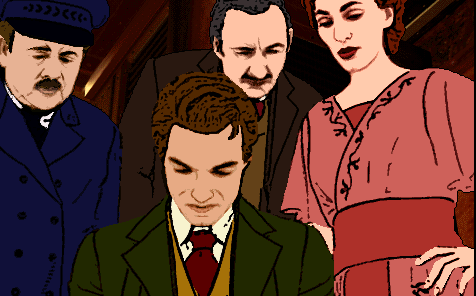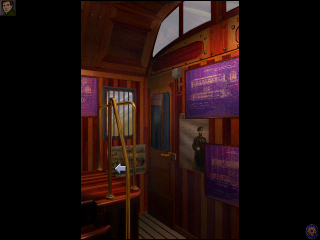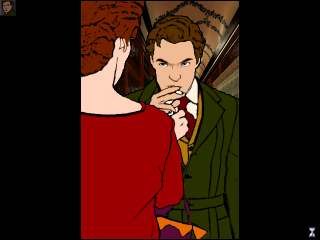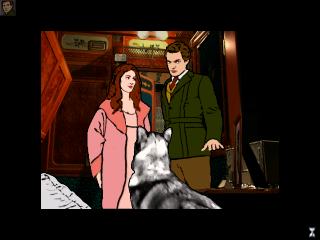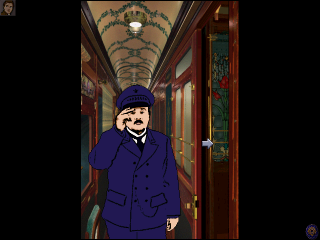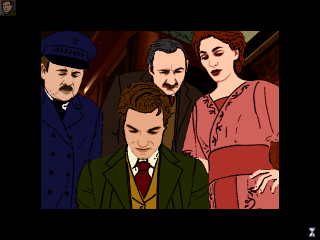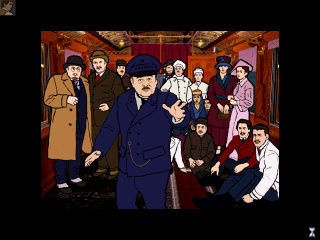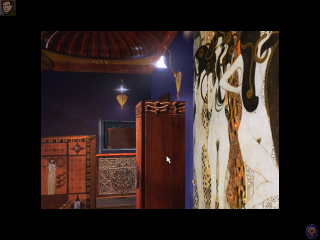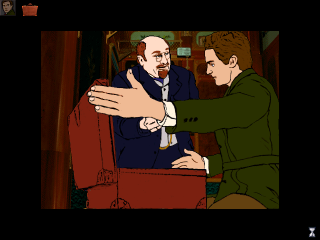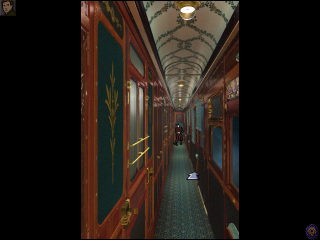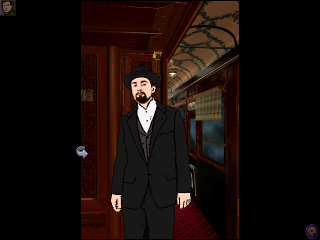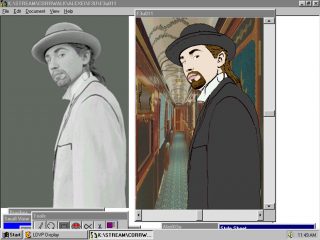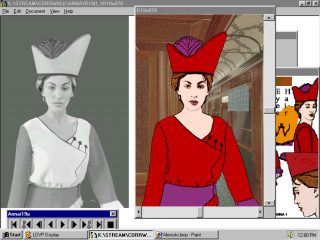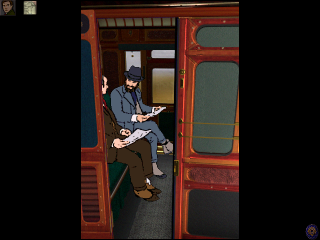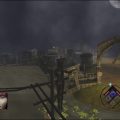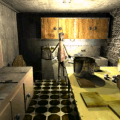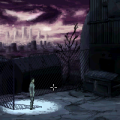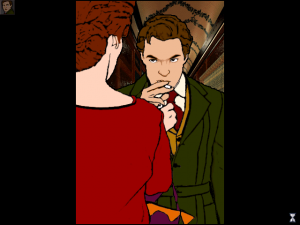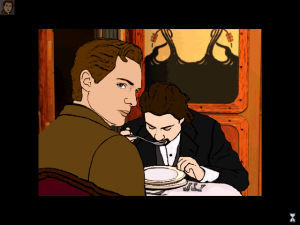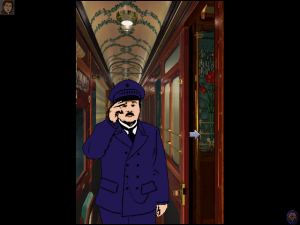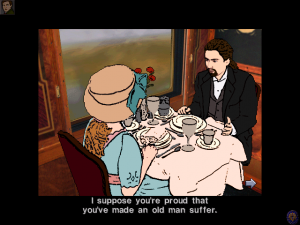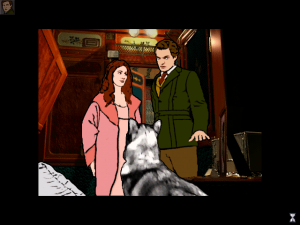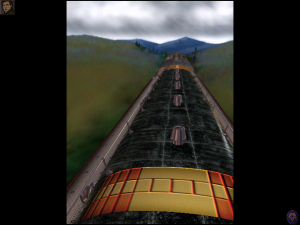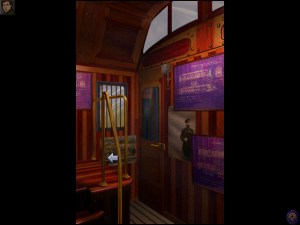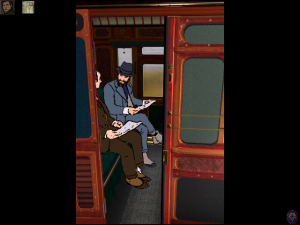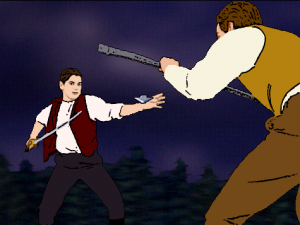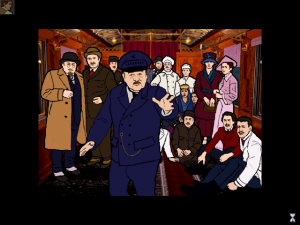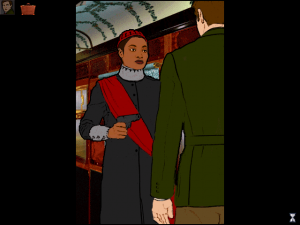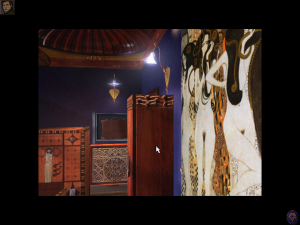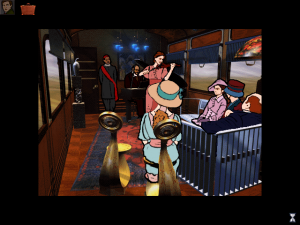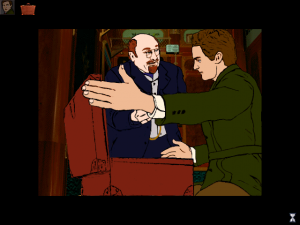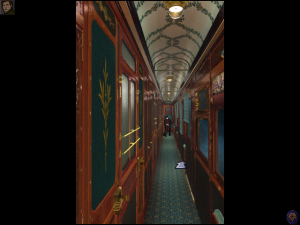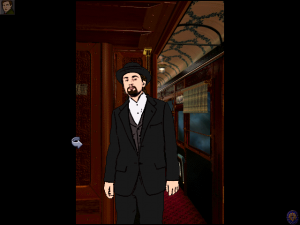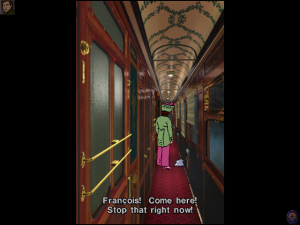The Last Express might be one of the most fascinating games ever made. Developed by a studio called Smoking Car Productions, it was helmed by Jordan Mechner, who up until this point was mostly known for the classic computer games Karateka and Prince of Persia. While these were action side-scrollers, both had a stronger cinematic bent that most other similar games, particular Karateka, where the camera would focus on an approaching enemy before your hero would fight him. Mechner’s heart was clearly in storytelling, which inspired him to create an adventure game. But the problem with most adventure games is that they rarely embrace their one big asset – their interactivity. They are often static and linear, with your character’s only real role being to listen to dialogue and move the plot forward. In the past, a handful of other games had tried to give the player a more active role in shaping the story, yet nearly all had failed in one way or another, simply because they’re too hard to develop. The Last Express attempts this admirably, and while it has its share of flaws, it succeeds more than all that have come before it, and probably most since.
The events of The Last Express begin on July 14th, 1914. Tensions are mounting all over Europe as the Archduke Ferdinand of Austria-Hungary had been assassinated by Serbian nationalists just weeks before. The Orient Express is setting out on its two-and-a-half day run from Paris to Constantinople, and while no one knows it yet, it’s the last time the journey will be made – the line was decommissioned after the beginning of World War I, hence the title The Last Express. It also wears its inspirations on its sleeve, obviously drawing from Dashiell Hammett’s The Maltese Falcon and Agatha Christie’s Murder on the Orient Express.
Characters
Robert Cath
The hero of The Last Express, Robert is a young doctor on the run from the law. Smart and capable, he keeps a cool demeanor in face of the numerous heists and plots he’ll need to untangle. He’s also the sole American on board the train.
August Schmidt
A weaselly German arms dealer. He was scheduled to meet with Tyler before his untimely death, an appointment Robert attempts to keep by assuming Tyler’s identity.
Tatiana Obolenskya
This young Russian student is traveling with her sickly grandfather Vassili, a wealthy aristocrat and staunch supporter of the monarchy.
Alexei Dolnikov
Alexei is a childhood friend of Tatiania’s who dreams of freedom from their country’s oppression.
George Abbot
Mr. Abbot is a British businessman, eminently likable in spite of his sticking his nose in a bit deeper than anyone really finds comfortable.
Anna Wolff
Anna is a famous (and beautiful) Austrian violin player, who is accompanied everywhere by her dog Max. Herself and Robert hit it off quite well. She also has a suspicious interest in August Schmidt, a balding mongrel way below her standards.
Milos Jovanovic
A friend of Tyler’s who initially mistakes Cath for a foe. He is a staunch supporter of Serbo-Croatian unity and is accompanied by three subordinates.
Prince Kronos
And at the end of the train is an overtly luxurious private belonging to Kronos, a mysterious African prince who also has some dealings with Whitney. While his demeanor is friendly, his stoic bodyguard Kahina – and the knives she carries – makes it evident that he is not a man to be trifled with.
Without any introduction, we find Robert Cath riding on a motorcycle parallel to the train just outside of Paris, leaping aboard while both are still in motion. We learn quickly that he is a wanted man, though the charges against him are purportedly false. He is called aboard the train to meet up with one Tyler Whitney, a longtime friend, although no reasons are given for their rendezvous. When Cath finds him, he is lying dead in his room, having apparently been murdered. After disposing the body and assuming his identity, Cath learns of the holes that Whitney has dug for himself. Not only is he in the middle of an arms deal with a weaselly German named August Schmidt, but he was also smuggling a precious artifact known as the Firebird, which has completely disappeared from his possession. Cath must not only fulfill the obligations of his departed friend, but foil other threats aboard the train as a result of the exploding pressure of a continent on the verge of war. As a period piece, each character (or group of characters) represents a nationality, and not all of them get along.
Many speak English, but many do not. Since most assume that Cath is the typically ignorant American, they are content to speak in their native tongues without reserve, sometimes speaking directly about him. Cath can understand French, Russian and German, which are subtitled at the bottom of the screen. However, he has no knowledge of Arabic or Serbo-Croatian, leaving both him, and the player, in the dark. Many conversations are simply about politics, or the economic climate, or just about random things. Not all of it is necessarily important to the core plotline, but it does greatly flesh out the narrative.
There are numerous threads that run throughout the whole journey. The young student Tatiana Obolensky of Russia is traveling with her sickly grandfather Vassili, a wealthy aristocrat and staunch supporter of the monarchy. Also aboard the train is Alexei Dolnikov, a childhood friend of Tatiana’s who dreams of freedom from their country’s oppression. While at times it seems like their romance may bloom, they are split apart by Alexei’s anarchist philosophies, a tragic element that ensures the two will never be together. It’s a subplot that plays off well because neither side is completely in the right – Alexei has very real reasons behind his anger, but at the same time, he’s also seen preparing a bomb to set the train ablaze. Although it’s ultimately not a big part of the story, it’s an important representation of the political fighting that led to the outbreak of the First World War.
Other characters are less important to the central plot, but help maintain a sense of realism. The Boutral family is traveling from their homeland of France to Turkey for the father’s job, and the resentment among them is quite evident. Mahmud Makita is transporting a harem of four young women who may not been seen nor disturbed. George Abbot is a British businessman, eminently likable in spite of him sticking his nose in deeper than anyone really finds comfortable. One of the travelers is a young American woman who keeps a diary. It can be read in her absence, as her private thoughts give a different perspective on the events than our own. (It also serves as a quick epilogue in certain Game Over sequences.) You can rifle through the belongings of one of the conductors, and amidst the manifests and job-related stuff, you find a sketchbook filled with drawings of the train’s passengers. Strewn around the cars are newspapers which relate the real-life events and help place the story in the proper historical context. Touches such as these quaintly add to the realism of the location, and the depths of the characters, which would otherwise go unnoticed.
The core elements of the plot are intriguing from the outset. Anna Wolff, the famous (and beautiful) Austrian violin player who is accompanied everywhere by her dog, shows a curious interest in August Schmidt, himself a rotund, balding mongrel way below her standards. There is obviously something quite suspicious about that. And at the end of the train is an overtly luxurious private car belonging to Kronos, a mysterious African prince who also has some dealings with Tyler Whitney. While his demeanor is friendly, his stoic bodyguard – and the knives she carries – makes it evident that he is not a man to be trifled with.
At the center of this is Cath, who, as an American, is technically an outsider to the conflict, having been drawn in by matters of fate. He is also a complete and total badass. To contrast the reservations of some of the European passengers, Cath is much more forward and confrontational, a true man of action. He possesses a dash of intelligence, him being both a skilled doctor and speaker of numerous languages. However, it is never over-the-top, in the way so many action movie heroes are. There are a few fight scenes – which are solely tests of reflexes, as you click the mouse button to dodge or attack foes – and a single swipe of a sword will kill him. He’s cunning but vulnerable, likeable but realistic. There’s quite a lot of off-screen character building. It’s inferred that Whitney and Cath had plenty of adventures in the past, but their history is mostly left unexplained, adding an aura of mystery to both of them.
With all of this, Mechner has created an extremely detailed story, far more stunningly written than most adventure games by itself, but that’s not what makes The Last Express so special. Rather, it’s how you interact with the world he’s created. The Last Express is played much like Myst and its ilk, using a first person perspective and a single cursor icon. The train is not large, consisting of a dining car, a parlor, and two sleeping cars, as well as Kronos’ car and the baggage room, both of which are generally off-limits. What’s unusual is that the game works on an accelerated real time scale, with the clock counting down even as you stand still.
The use of a real time clock is not new amongst adventure games – even some of the early King’s Quest games did it – but they usually acted as little more than simple time limits. Its implementation in The Last Express is far more complicated, as it governs the entire flow of the narrative. Each of the characters acts according to a script, moving to and from certain locations, eating dinner, chatting in the smoking car, or simply relaxing in their room.
In a lot of ways, The Last Express is a more modern implementation of Sierra’s The Colonel’s Bequest, another mystery game from nearly a decade prior. That game worked on a similar principle, in that the story took place in a confined environment and was largely character driven. However, it did not operate in real time, instead moving forward in “time blocks” triggered by certain actions, an element which was abstract and confusing.
But for as much as The Last Express improves on Sierra’s almost-classic, it falls into the same basic problems – there is very little actual direction, and most of the game is spent simply clicking back and forth through the train cars, hoping to stumble upon something. Indeed, most of your time aboard the train consists of listening to the passengers converse. There are very few adventure game-style puzzles, and their appearances are jarring when they do pop up.
There are, of course, a handful of key moments where you need to take action – recovering the Firebird during a concert, defusing Alexei’s bomb, saving the train from terrorists – but it’s not always clear what you’re supposed to be doing until it’s too late. That’s kind of how the game is structured to work, oddly enough – at any point you can rewind time as far as you want, allowing you to fix any screw-ups, up to and including your own deaths. (This feature was later reused, to an extent, in the 2003 Prince of Persia reboot, The Sands of Time.) As established in the opening segments, when you need to get rid of Whitney’s body, you’re almost expected to lose and then travel back in time to find a workaround. Whenever you do get a Game Over, the game will automatically rewind time to a point where you can fix your mistakes, giving you some kind of a clue of what you’re supposed to be doing. As a result of the action running in real time, there are moments where there simply isn’t anything happening. There is no way to speed up time, so the only option is to wait it out. But there’s still a sense of aimlessness that’s hard to overcome, and it can easily frustrate.
While major plot events occur at set times, you can accomplish certain tasks in any order, and conversations can potentially change based on who you’ve talked to or where you’re talking with them. Right from the beginning, there are two ways to handle Whitney’s corpse. You can chuck him right out the window at the outset, but since you’re so close to Paris, it will alert the cops, who board the train and cause an extra bit of trouble. Or, you can go through some extra steps to hide Whitney’s body and make sure the conductor doesn’t find it, and then dispose of it once you’re out in the countryside. Even though The Last Express isn’t an incredibly long game, it’s far more replayable than most, offering numerous dialogues to discover, or events that play out slightly differently based on your actions. Subsequent playthroughs actually become easier once you have a grasp on what you’re supposed to do and when. But even those don’t work consistently. The game is very particular about what you can and can’t do – you can only speak to characters when and where the game allows you, rendering them solely as background elements when you can’t. Amidst all of the clearly bad endings, which result in either the train blowing up, or Cath either getting killed or arrested, there are a handful of other possible outcomes based on your actions. In spite of them not being “bad”, per say, there is only one correct conclusion, and it would’ve been nice if they expanded on the others rather than railroading you into one particular finale. It’s a restrictive but essential evil, giving how difficult it would be to predict every single possible approach.
The narrative and structure are not the only elements unique to The Last Express, because it is also a strikingly stunning visual experience. Like Myst, the backgrounds are all computer rendered. But while many of those types of games sought to establish fantastic environments, The Last Express instead seeks to replicate the look and feel of the actual Orient Express. The development team found an old car in Europe and used it to meticulously model the virtual one in the game, resulting in a feeling of genuine authenticity.
However, the beauty of the environments is often overshadowed by the gorgeous character artwork. Conscious of the fact that CGI rendered humans looked awful and FMV was often hokey, The Last Express instead uses rotoscoped animation. The process, also used in Mechner’s previous games, is where a human is filmed performing various actions, then traced and recolored by a computer. In both of his earlier games, the sprites were quite small and indistinct. Here the rotoscoping is used as if it were for a whole movie – or, perhaps more accurately, a comic book. The animation is inconsistent, most often moving at about a frame a second, but it is occasionally smoother during certain scenes. The effect is slightly jarring, as single frames blend into each other in attempt to simulate movement, but the awkwardness fades once you become accustomed to it. When it is fully animated – when passing characters in the train hallways and during fight scenes – it looks completely amazing, but considering it already took the developers five years to put out this game, a full motion effort was undoubtedly far out of reach.
It still looks incredible, though. Whenever any character brushes up against you, they excuse themselves and look straight into your eyes, often giving you a quick and friendly nod. It’s a subtle touch that more wholly immerses you in the environment, an important element when so many other games seem to relegate the player as a floating entity. It helps The Last Express stand out from its peers, and while the technique has since shown up in a few movies – most notably, A Scanner Darkly and Waking Life – it does little to lessen the visual impact.
Historical fiction is rare in the gaming medium, beyond the endless recycling of the Romance of the Three Kingdoms or alternate universes a la Command and Conquer: Red Alert, which are only used as background for fighting anyway. Reading up on the background of World War I is imperative to fully understand it, something which the official hintbook politely provides. Beneath that surface lies one of the most immersive environments committed to a digital medium. Sure, there are those who will hate the game for its unconventional structure. The huge limitations are undeniable, of course, but within the framework it establishes, it becomes incredibly, deeply involving, one that truly takes advantage of interactive storytelling in ways that very few even attempt.
But for all of the effort that went into The Last Express – and all of the praise lavished upon it by critics at the time – it was a huge commercial flop. Part of it was the general state of the adventure game industry, which was ailing back in 1997. And another part of it was the fact that the marketing department at Brøderbund, the publisher, had quit right before it was released, resulting in a game with no real advertising. Together with numerous other factors, it spelled the death for Smoking Car Productions. They went out with a helluva bang, considering that single game is widely considered one of the hallmarks of the genre.
